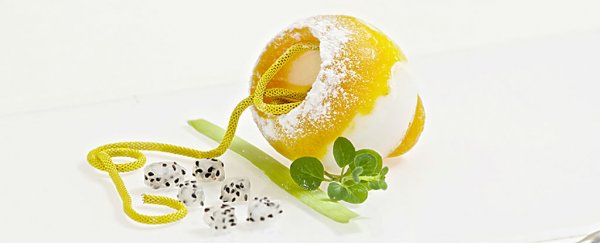Researchers have come up with an awesome way to address that rather serious plastic problem we've got going on - a device that turns plastic waste into a safe, edible product, thanks to two strains of fungus that digest the plastic ingredients, but don't accumulate anything toxic.
"We were both really inspired about the idea that something digests plastic but then still creates edible biomass," one of the inventors, Austrian designer Katharina Unger, told Kaleigh Rogers at Motherboard.
Called the Fungi Mutarium, the technology has been in development for a few years, and Unger is now working with microbiologists to figure out how many different types of mushrooms they can use, and how to up the efficiency of the decomposition process.
"We know that there's potential to speed up this process simply by optimising the processes around it: temperature, humidity, the perfect microclimate for this fungi to colonise the plastic material," says Unger. "Also, though it's more controversial, there is genetic modification. What happens if you modify the organism so that it can process the materials more quickly?"
Here's what the prototype looks like:
It's a pretty 'out-there' idea, but when it comes to plastic, we need all the help we can get. A recent report estimated that within the next 35 years, the number of fish in our oceans will be outweighed by plastic waste, and by 2050, we'll be producing more than three times as much plastic as we did in 2014.
Technologies that could reduce a lot of this build-up - like China's new waste-to-energy plant - come with their own problems, because burning plastic releases carbon dioxide into the atmosphere that we really don't need.
That's what makes the idea of the Fungi Mutarium so intriguing - it not only uses nature to process synthetic waste, it results in a product we can actually use: food.
The idea came from a 2012 study by researchers at Yale University, who found a rare mushroom in the Amazon called Pestalotiopsis microspora that was capable of breaking down polyurethane - the main ingredient used in plastics. Not only could this fungus live entirely off polyurethane, it could do so in an anaerobic (oxygen-free) environment that resembles the bottom of a landfill.
As it turns out, species of plastic-eating fungus are actually pretty common, and together with fellow designer Julia Kaisinger and scientists from Utrecht University in the Netherlands, Unger identified two that would be perfect for their device: Pleurotus ostreatus - aka the oyster mushroom - and Schizophyllum commune, a species that's listed as inedible in the UK and US, but is popular in parts of Mexico and India.
The device features a series of little white cups that are made from agar (seaweed-derived gelatin), starch, and sugar, and thin slices of plastic waste that have been previously sterilised with UV light are placed inside. The mycelium (or roots) of P. ostreatus and S. commune mushrooms are dropped into the cups, and as they grow, they feed off the plastic waste and nutrients in the cup walls.
"In just a few weeks, fungi begins to grow out of the pods, using the plastic to feed its development," Fiona MacDonald reported for us back in 2014. "After several months, the plastic will be completely decomposed and you're left with nothing but an agar cup filled with edible fluffy white mycelium."
While eating mushrooms that have been processing plastic waste for the past few weeks doesn't sound all that appetising or safe, the fact that the mushrooms aren't all that interested in retaining the toxic components of the plastic means they don't accumulate it in their cells, so, in theory, they're safe for us to eat.
I say "in theory", because the research behind the prototype is yet to be published or peer-reviewed, and there will need to be a whole lot of testing before we can have one of these nifty little farms in our homes, but the team is working on it. While the actual prototype might not ever get off the ground, Unger and Kaisinger say the best thing to come out of the project is being able to collaborate with biologists and come up with creative, science-backed ideas that just might stick.
"We were mainly there in the lab to ask questions that designers ask and stimulate our researchers to think differently about the work that they're doing and also about the possible applications of it," Unger told Motherboard.
If they gave me something as beautiful as this to eat, I wouldn't say no.
